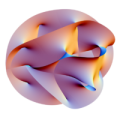 I’ve just found an amazing 2002 article [pdf] from the American Mathematical Society about blind mathematicians.
I’ve just found an amazing 2002 article [pdf] from the American Mathematical Society about blind mathematicians.
I was surprised to learn that the majority work in geometry, supposedly the most ‘visual’ discipline, and fascinated to learn that they generally believe the experience of sight puts people at a disadvantage because it locks us into a perception-led view of space.
This can be a problem in geometry because it regularly works in problems that involve more than three dimensions or requires an understanding of objects from all ‘angles’ simultaneously.
Alexei Sossinski points out that it is not so suprising that many blind mathematicians work in geometry. The spatial ability of a sighted person is based on the brain analyzing a two-dimensional image, projected onto the retina, of the three-dimensional world, while the spatial ability of a blind person is based on the brain analyzing information obtained through the senses of touch and hearing. In both cases, the brain creates flexible methods of spatial representation based on information from the senses. Sossinski points out that studies of blind people who have regained their sight show that the ability to perceive certain fundamental topological structures, like how many holes something has, are probably inborn…
Sossinski also noted that sighted people sometimes have misconceptions about three-dimensional space because of the inadequate and misleading twodimensional projection of space onto the retina. “The blind person (via his other senses) has an undeformed, directly 3-dimensional intuition of space,” he said.
There is not any maths in the article but it is written for mathematicians so it contains lots of mysterious sentences like “Morin first exhibited a homotopy that carries out an eversion of the sphere in 1967”.
However, the article is also a fantastic history of blind mathematicians and has lots of quotes from current leaders in the field who explain who their supposed disability lets them better understand the maths of three and more dimensions.
Even for those without a maths background it’s an amazing insight into some remarkable people.
pdf of ‘The World of Blind Mathematicians’ (via @tiempoasm).
Interesting. However, Sossinski’s claims about the perceptual basis for this are way off base.
1. Vision isn’t based on a 2D retinal image, it’s based in the 3D perspective geometry of the optic array. The retinal image is a (misleading) analytic tool, nothing more.
2. There is no ‘privileged access’ to the 3D world via touch. Proprioception is perception and is based in the same type of information as vision; kinematic specification of dynamics. Bishop Berkeley was wrong about touch being the special sense that solves the 3D problem in vision.
Touch and vision do inform and calibrate each other, and they complement each other with access to different properties at different times. Whatever the reason there’s so many blind mathematicians doing geometry, this isn’t it.
“Sossinski also noted that sighted people sometimes have misconceptions about three-dimensional space…”
Incredible! To think that sight is interfering with our understanding of a visual discipline!
I think Andrew is right, vision is based in the 3D perspective. However it’s impressive what can “see” the blind people.
Morin told me that when he imagined a 3D form he had a ‘point of view’ to one side of it: not like the way we see a 2D figure, as a whole.
It may be relevant that Morin was not born blind, but became blind in early childhood, so that some of his formative spatial experience was visual.
A different take on the attraction of geometry for the blind, rather than the primacy of proprioception/touch, is this: suppose you have an intense sense of shape, and capacity to rejoice in it, for whatever neurobiological reason. A sighted person can feed that just by looking at trees and clouds and actors, but shape input for the blind is far less rich, and must be struggled for. Ordinary language is far too weak to give an alternative input, but mathematics can specify glorious spatial complexity. In my first contact with Morin he told me _over_the_phone_ how to evert a sphere, and two weeks later I took him a carved sequence of models.
So perhaps it is less that blind mathematicians become geometers, than that blind spatial minds become mathematicians. Blind people centred on other inputs, like sound and music, have less need for it.